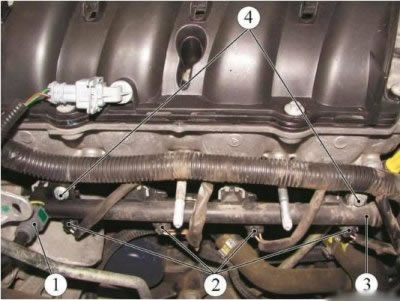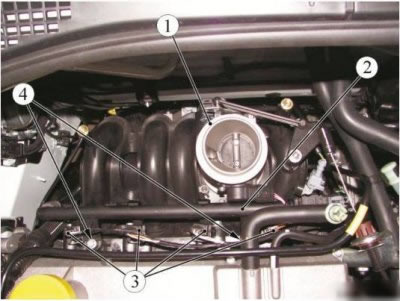 |  |
Fuel rail and fuel injector
Removing
Place the car on the workplace, brake with the parking brake, turn off the ignition.
For station wagon
Tilt the rear row of seats forward (for 5-seater configuration) or middle row (for 7-seater configuration).
Detach and lift upholstery.
Remove the hatch cover of the electric fuel pump.
Disconnect connector 1, Figure 2-1, rear wiring harness from fuel pump module 2.

Figure 11-12 - Disconnecting the rear wiring harness block from the fuel pump module: 1 - block of the rear wiring harness to the fuel pump module; 2 - electric fuel pump module; 3 - fuel tank
Start the engine and let it run at idle until it comes to a complete stop to relieve pressure in the fuel system, ensuring that exhaust gases are removed (exhaust coil with fan type SERF/SP f. "SovPlym"). Switch off the ignition.
Disconnect wire terminal "masses" from the battery.
Connect the block, wiring harness to the fuel pump module. Install the hatch cover of the electric fuel pump. Install and secure the floor upholstery.
lower rear (for 5-seater configuration) or medium (for 7-seater configuration) row of seats.
For vehicles with K4M engine
Unscrew two nuts 1, Figure 11-13, and remove the protective cover 2 of the fuel rail (interchangeable head 13, extension, crank).

Figure 11-13 - Removing the fuel rail guard: 1 - nuts for fastening the protective casing of the fuel rail; 2 - protective casing of the fuel rail
Press the spring clip of the pipe connector 1, Figure 11-14, and by moving along the axis of the fitting, disconnect the pipe 1 from the fuel rail 3.
Attention. For cars with a body "van" preliminarily cover the place of the fuel pipe connector with the fuel rail with a rag and prevent fuel ejection when the fuel line is disconnected, since the pressure in the fuel line is maintained

Figure 11-14 - Removing the fuel rail of the K4M engine: 1 - fuel pipe; 2 - pads of the wiring harness to the injectors; 3 - fuel rail; 4 - fuel rail mounting bolts
Disconnect the wiring harness connectors 2 from the fuel rail injectors 3.
Unscrew two bolts 4 and remove the fuel rail 3 complete with injectors (interchangeable head 8, extension, crank).
Press the spring clip of the connector and disconnect the supply line 1, Figure 11-15, from the fuel rail 2.
Attention. For vehicles with a body "van" preliminarily cover with a rag the place of the connector of the fuel pipe with the fuel rail and prevent fuel ejection when the fuel line is disconnected, since the pressure in the fuel line maintains

Figure 11-15 - Disconnecting the supply pipe from the fuel rail: 1 - supply pipeline; 2 - fuel rail
Remove throttle pipe 1, Figure 11-16 (see above).

Figure 11-16 - Removing the fuel rail of the K7M engine: 1 - throttle pipe; 2 - fuel rail; 3 - pads of the wiring harness to the injectors; 4 - fuel rail mounting bolts
Disconnect the wiring harness connectors 2 from the injectors.
Unscrew the two bolts 4 fastening and remove the fuel rail 2 (interchangeable head 8, extension, crank).
Installation
Attention. The sealing rings of the injectors must be replaced.
Before installing the fuel rail on the engine, install new o-rings on the nozzles, having previously lubricated them with engine oil.
Install the fuel rail to the engine.
Install and tighten the fuel rail mounting bolts.
The moment of an inhaling of bolts of fastening of a ramp 9 Nm (0.9 kgf·m) (interchangeable head 8, extension, knob, torque wrench).
Connect the wiring harness connectors to the fuel rail injectors.
Attach the fuel pipe to the fuel rail by moving along the axis of the fitting until the connector snaps into place. Check the tube is secure.
For cars with the K4M engine additionally: install the protective cover 2, Figure 11-13, of the fuel rail on the engine, screw in and tighten the nuts 1. The tightening torque of the nuts is 21 Nm (2.1 kgf·m) (interchangeable head 13, extension, knob, torque wrench).
Operations for all vehicle configurations
Attach wire terminal "masses" to the battery.
